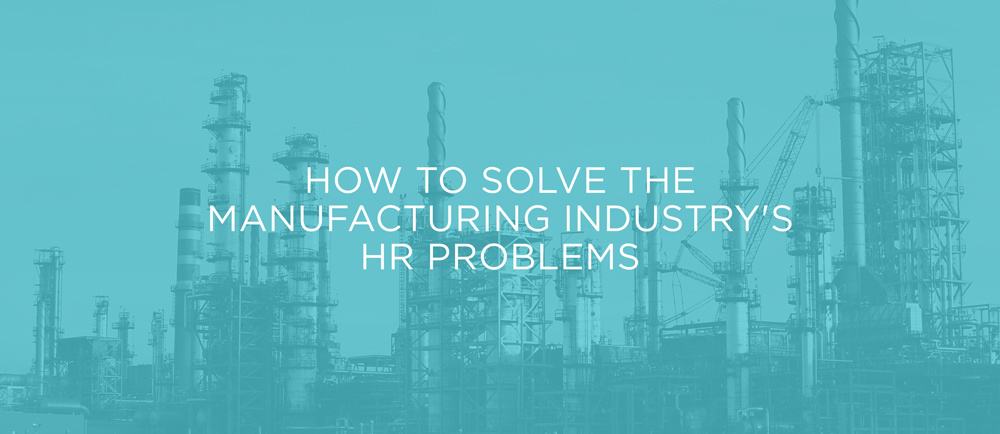As the old saying goes, knowing is half the battle. To that point, while we previously discussed the challenges facing the manufacturing industry with respect to HR and human capital, understanding those underlying challenges is an important but, ultimately, single component to addressing and fixing them.
By isolating and analyzing each of the HR-related issues in the manufacturing industry on an individual basis, distinct strategies can be developed to maximize the effectiveness of various solutions, ranging from marketing tactics and technology platforms to corporate culture enhancement and training procedures.
Collectively, these types of strategies can address the primary issues facing HR in the manufacturing sector to help it reach the potential it has exhibited in the recent decade as it continues to play a vital role in the overall health of the nation’s economy.

Workforce Shortage
In the particular case of an increasing workforce shortage within manufacturing, a highly segmented problem requires a varied and layered approach to find resolve. Therefore, adopting a series of specific procedural steps can significantly help HR mitigate the broad-based issue.
Eliminate Information Silos
Just like the many different types of equipment used on a manufacturing line, the highly specialized skill sets and best practices in the typical manufacturing workflow should be treated as an asset and protected accordingly. HR and management shouldn’t treat this workflow as a given but, instead, take the time and effort to fully understand the process involved. Such understanding can help develop internal training programs to better acclimate new employees.
Enhance Overall Productivity
Relying on antiquated, outdated processes for modern, dynamic needs only hinders production. Therefore, procedures that are mired in ineffective and error-prone, paper-based systems are not only inherently inefficient but also fail to appeal to the more tech-oriented worker base that is so desired by the manufacturing sector. Old-fashioned procedures present an increasingly insurmountable barrier to attracting new, digitally-savvy talent.
Empower the Workforce
Of course, while attracting such new talent is critical to future success, current success is entirely dependent on the existing workforce. Implementing an MES or paperless manufacturing system will empower current workers and significantly enhance management’s ability to regulate and efficiently administer teams, procedures, and machinery throughout all phases of production.
Collecting feedback from employees throughout their employee lifecycle will help ensure they feel heard. This is especially important if manufacturing hopes to attract the younger generations. When changes are implement to processes or management based on this employee feedback, your workforce will feel more than empowered.
Workflow Management
Paperless manufacturing can also significantly reduce errors from workers that fail to thoroughly read and absorb specific work instructions. Such new systems can ensure all necessary steps are precisely followed on a shop floor. In essence, the system serves as a digital instructor of sorts, making sure the benefits of knowledge and experience are seamlessly transferred when key employees and their wealth of specialized knowledge – manufacturing engineers in particular – are lost to retirement or attrition.
Minimize Technology Gaps
While analyzing the different processes and procedures, be diligent in identifying any gaps that are exposed along the way, developing strategies to permanently address those discrepancies. Likewise, it is important to avoid a myopic perspective that devotes lopsided attention to any individual component of the manufacturing value chain because, as another saying goes, you’re only as strong as your weakest link. Devoting disproportionate resources toward a single area will provide no benefit if other underachieving areas will still inhibit operation-wide efficiency.
Make Needed Change to the Culture
The manufacturing industry need not look any further than its difficulty in attracting new, highly-skilled labor to identify its growing image problem. While marketing campaigns and expanded technology platforms can certainly alleviate some of the negative perceptions – justified or not – towards the sector, making fundamental changes to the underlying culture is the only way to directly address the heart of the problem. Manufacturing needs to buck many of its more traditional, wait-and-see approaches and take any underlying cultural issues head-on. Appealing to dynamic, tech-oriented talent requires a far more dynamic solutions than the status quo and outdated, passive philosophies. There is no better source to understand how culture changes and new initiatives are being received than the employees themselves. Again, collect feedback at before, during and after culture initiatives are implemented to measure their success.

Recruitment Challenges
Recruiting, of course, is a multifaceted concept that requires a multifaceted approach in order to maximize success. Establishing and fostering an appealing recruitment and overarching brand will significantly increase the likelihood of prospective talent actively engaging with your recruitment message. In other words, the more familiar someone is with your organization, the more apt they are to respond to your emails and messaging.
Enhancing Your Recruitment Brand
To that point, there are four distinct steps that can help you develop a brand that is attractive to the particular segments of candidates desired.
- Take a proverbial walk in a jobseeker’s shoes. Try to assess your brand from your target’s perspective, adopting an honest and realistic approach, not one that is overly idealistic.
- Properly define your recruiting message to help build a brand that is truly reflective of the values and underlying mission throughout your organization.
- Be financially responsible with your approach, adopting measures to improve your brand without creating a new and formidable line item on your expense statement.
- Implement a comprehensive course of action that allows you to actively manage and maximize your employment brand both today and tomorrow.
Leverage Social Media
Given the ubiquitous nature of the various social media platforms throughout society, many of which already occupy a critical role in the recruitment process, developing a successful brand now relies on your ability to create engaging content and attract potential candidates that might otherwise have turned a blind-eye to your recruitment message.
Specifically, infusing various forms of paid promotional content throughout your social media will allow you to target specific talent with far higher degrees of precision and impact. By designing and distributing your social media or email outreach by targeting particular affinities like job experience, interests, and a variety of other demographic points, you can far increase the likelihood of your content reaching the desired audience segment.
Employee Referral Program
In light of the prevalence of those social media platforms, leveraging the heightened connectivity between people to your recruiting benefit can pay significant dividends. Implementing a reward system that incentivizes your current workforce to recommend a position within the organization that eventually leads to a hire can vastly expand your recruiting reach while simultaneously vetting a candidate through the referral itself. The success of any such program is contingent upon the reward being based on a successful hiring outcome rather than the referral itself. Otherwise, HR would likely be barraged with an endless stream of empty and inconsequential referrals.
Simplify the Process
Once again referencing the increasingly dynamic nature of the aggregate workforce, the recruiting process should be agile and streamlined in order to accommodate varying schedules and maximize convenience. A laborious, drawn-out interview and hiring experience will, more often than not, lead candidates to lose interest and quickly become frustrated with interminable application procedures and too many interviews conducted by multiple people at multiple times.
Try to infuse maximum flexibility and expediency into recruitment procedures in order to shorten the process as much as possible without sacrificing efficacy and impact. Always remember, every minute spent in excess throughout the process makes your organization a minute closer to losing a potential candidate to a competitor with a faster, more agile recruiting system. Implement surveys to new hires about about the recruiting and hiring process to see how this process might improve.

Retention and Attrition
Although previously discussed in great detail, factors impacting employee retention and manufacturing are important enough to bear repeating given the already sparse existing workforce and recurring recruiting deficits. Suffice it to say, while compensation issues might be the most popular theory behind attrition, technology is able to reveal the true, often nuanced drivers of attrition – primarily through people analytics – that many employers find surprising.
As an example, the unique, actionable insights provided by technology have shown that specific dates and events – including employment anniversaries, birthdays, class reunions, and a variety of personal milestones – often serve as the trigger point to an employee leaving an organization. In fact, between those three primary triggers, job-hunting rates can increase as much as 9%, 12%, and 16%, respectively. Successfully employing technology can afford companies a much deeper understanding of employee wants and expectations, providing them the opportunity to make necessary changes before turnover increases and productivity plummets.
Many of those worker expectations are dependent upon a sense of confidence in an organization’s leadership. In fact, management has proven to be the primary factor in attrition, often due to an underlying inability to effectively communicate with teams and a workforce in general.
To not only counteract the negative impact of ineffective communication but, more importantly, learn from where they might be succeeding or failing, HR must consistently collect feedback from employees and deliver key insights to management in order to establish a healthy, meaningful, and communicative foundation that the entire organization can always rely upon.

Low Employee Engagement
Given the existing issues in both attracting and maintaining sufficient talent, manufacturers must maximize employee engagement and, thus, the productivity of every individual worker. Making sure each employee feels like they matter plays a critical role in this concept, providing the workforce a much-needed sense of direction and belonging within an often complex organizational infrastructure.
Rather than feeling like just another face in the crowd, management needs to establish a system to collect consistent feedback from their employees. Betterworks Engage’s own engagement platform, for instance, gives HR and corporate management the ability to constantly deliver surveys, polls, and bottom-up, open-ended feedback to better understand every individual within a company.
Likewise, leadership should be available and engaged to properly facilitate true employee engagement. When managers are open and receptive to employee concerns, they can incorporate such feedback into future, more enriching procedures that can make employees feel like their voice is impactful and meaningful.
Conducting town hall meetings, roundtable discussions, and even meetings between customers and employees further enhances a feeling of empowerment for workers as they can discuss and observe the impact a manufacturer’s products has on the customer base.
Heightening the sense of individual control over an often highly regimented work today can also be beneficial in improving employee engagement levels by reducing repetition, general tedium, and worker malaise – all of which can significantly dampen engagement and, consequently, productivity. The most effective manufacturing leaders can find a balance between efficient, reliable internal procedures and sufficient individual control that expands personal choice.
To capitalize on such empowerment, a system of parallel accountability also needs to be implemented to protect both the organization and workforce from the negative impact of poor choices and substandard work by individual employees. If properly utilized, accountability measures can also increase engagement by fostering a sense of teamwork and greater good, where underperforming employees and managers are held responsible for their actions and fledgling production levels.

Training and Development
As a continuation of the recruitment process as well as a key factor in enhancing employee engagement and minimizing attrition, training and development programs establish and maintain a healthy and productive foundation for manufacturers heavily reliant upon maintaining and extending their human capital.
Onboarding
Of course, before an organization can even begin to properly develop their workforce, they must make sure new employees are immersed in a productive sense of culture and feel adequately educated and prepared to succeed. Regular and consistent feedback programs throughout the onboarding process can help an employer better understand how engaged new hires feel and provide insight on how to improve the process as a whole. HR should automate this process for their organization using an employee feedback solution like Betterworks Engage.
Training
At their essence, training systems should be designed with the simple and straightforward goal of conveying information and guidance that will improve the knowledge base of any particular topic. The results of such systems should provide a demonstrable understanding of the underlying material that is necessary for the employee to find success within the organization.
While training programs and software can be expensive, there are alternatives that can be both cost-effective and beneficial to maximize the benefits of internal training procedures.
- Employee Cross-Training: Employees share various techniques and knowledge with colleagues on how to best perform their most important tasks. In doing so, they ensure their work responsibilities can still be fulfilled during work absences by other team members that have developed additional skills through the cross-training.
- Employee Monitoring: Mentors are paired with protégés with matching interests according to similar career paths, work histories, and goals. The commonalities between the mentor and protégé will maximize communication and, therefore, significantly enhance the benefits of the training.

Global Competition
Manufacturing is especially susceptible to the forces of outside competition, particularly with respect to the ever-increasing power and abilities of the collective global marketplace. To that point, Deloitte conducted a study that examined the key factors in determining if a manufacturer can create and maintain competitiveness in such a crowded and contentious environment.
Always Make Certain Talent Is the Top Priority
Employing different strategies that are specifically designed to target talent acquisition, development, and retention can help a brand be regarded as an employer of choice across multiple talent segments.
Likewise, developing models that leverage a collaborative spirit with outside talent sources will – along with those strategies – place an emphasis on the importance of talent to an organization, therefore serving as a critical driver of competitiveness that will well-serve a company within a fierce global market.
Embrace Advanced Technology to Drive Competitive Advantage
Various technologies are becoming increasingly imperative in establishing global manufacturing competitiveness. The most successful manufacturers are those that have fully merged the digital world with the physical one, leveraging the potency of both hardware and software, sensors, and big data to create smarter products and procedures, magnifying the connectivity with customers, suppliers, and operations.
These technology-driven concepts are best exemplified by predictive analytics, IoT, smart products and factories, and the constant development of advanced materials to fuel future competitiveness.
Developing innovative strategies that fully embrace a broader ecosystem and take proper advantage of burgeoning technologies will be absolutely crucial for future competitiveness. In fact, a manufacturing company’s ability to effectively compete will be directly correlated to the strength and thoroughness of its underlying collaborations and ecosystems.
Developing Balance Across a Global Enterprise
With footprints that can spread across several different regions, countries, and even continents, sophisticated tools and strategies will be needed to greatly enhance the impact and efficiency of talent, operations, technology, finances, and regulations across the varied segments of a global manufacturing enterprise.
The effectiveness of such of an approach is contingent upon finding the proper balance between innumerable success drivers, including talent management, investment in innovation, portfolio optimization, cost efficiency, geographical efficiency, and a hyper-complicated supply chain that needs to be able to flourish in a rapidly evolving global marketplace.
Cultivate Deliberate, Strategic Public Partnerships
Given those expanding geographical footprints, the role foreign government policy plays in manufacturing success increases by the day. Likewise, governments are well aware of the economic benefits the manufacturing industry can lend to national prosperity.
Therefore, nations with excessively bureaucratic or generally unfavorable policies are quickly instilling improvements and reform measures to better attract the economic development that a strengthened manufacturing infrastructure can provide.
In turn, global manufacturers are actively developing and fostering strategic partnerships with foreign governments to help implement improvements that simply would not be possible on their own. While the resulting alignments might seem nontraditional at first glance, they are quickly becoming commonplace as the global competitive environment rapidly transforms from both the corporate and governmental perspective.
While manufacturing companies are posed with many human resources challenges that can act as barriers to a successful future, adopting a deliberate approach that establishes specific strategies for specific underlying issues is the most effective manner to address those challenges. With our innovative platform that allows organizations to draw the actionable insights needed to both identify and implement needed change, Betterworks Engage is proud of the place it holds within the HR technology space, helping the manufacturing industry fully leverage the power of its own workforce, engage its human capital, and take full advantage of the economic importance the sector holds for the global marketplace.






